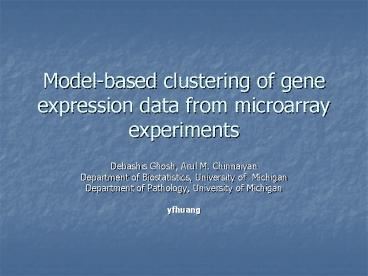Modelbased clustering of gene expression data from microarray experiments PowerPoint PPT Presentation
1 / 21
Title: Modelbased clustering of gene expression data from microarray experiments
1
Model-based clustering of gene expression data
from microarray experiments
- Debashis Ghosh, Arul M. Chinnaiyan
- Department of Biostatistics, University of
Michigan - Department of Pathology, University of Michigan
- yfhuang
2
Outline
- Introduction
- Systems and Methods
- Algorithm
- Implementation
- Results
- Discussion
3
Introduction
- Large collections of gene will be rapidly
available for parallel genomic studies - Currently two platforms to dominate the
microarray field oligonucleotide arrays and
spotted cDNA arrays
4
Introduction (Cont)
- Clustering methods are useful when the goal is to
discover grouping in the gene expression data,
and no external information exists. - An attractive feature of the model-based approach
is that it provide a statistical criterion for
accessing the number of true clusters in the
dataset of interest.
5
Systems and Methods
- Data Preprocessing
- Model Specification
- Density function
- Multivariate normal density
6
Algorithm
- Two Steps in fitting model to the data
- Initialization by model-based hierarchical
agglomerative clustering - Maximum likelihood estimation using EM algorithm
- A criteria for determining the number of clusters
in the data
7
Hierarchical Agglomerative Clustering
- Classification log-likelihood
- To find the maximizer of classification
log-likelihood - Base on a combination of the dissimilarity matrix
and a method of defining distance between clusters
8
Expectation-Maximization Algorithm
- Complete-data likelihood
- Log-likelihood
9
Expectation-Maximization Algorithm (Cont)
- Estimator
10
Selecting the number of clusters
- Determining the number of clusters based on Bayes
Factor - Bayes Factor
- Bayesian Information Criterion (BIC)
11
Implementation
- Model-based clustering in microarray studies
- Analysis of genes and ESTs (Expression Sequence
Tag) - Number of samples profiled (n) ltlt the number of
genes on a microarray (p) ? impossible to fit the
model to these data
12
Implementation (Cont)
- Model-based clustering of genes
- Using k-means clustering for preprocessing step
- Model-based clustering of samples
- Using principal components analysis for dimension
reduction - Using Bayes factors to determine the number of
clusters - Software
- Using MCLUST
13
Result
- Cutaneous melanoma data
- Data cDNA microarray experiments performed by
Bittner et al. - 31 melanoma samples
- Microarray contains 8150 human cDNA, of which
6912 were sequence verified.
14
Result (Cont)
- Prostate cancer data
- Data 3955 genes across the 26 samples
- Original data 9984 (5000 known gene from
Research Genetics human cDNA clone set, 4400
ESTs, 500 control elements)
15
Cluster Dendrogram (Bittner)
16
PCA of Melanoma Data
17
(No Transcript)
18
PCA of Prostate Cancer Data
19
(No Transcript)
20
Discussion
- A attractive feature of the model-based
clustering methodology is that the strength of
evidence measure for the number of true clusters
in the data is computed - Bayes factor for model specification
21
Reference
- Principal Components Analysis(PCA)
- Bayes Factor

